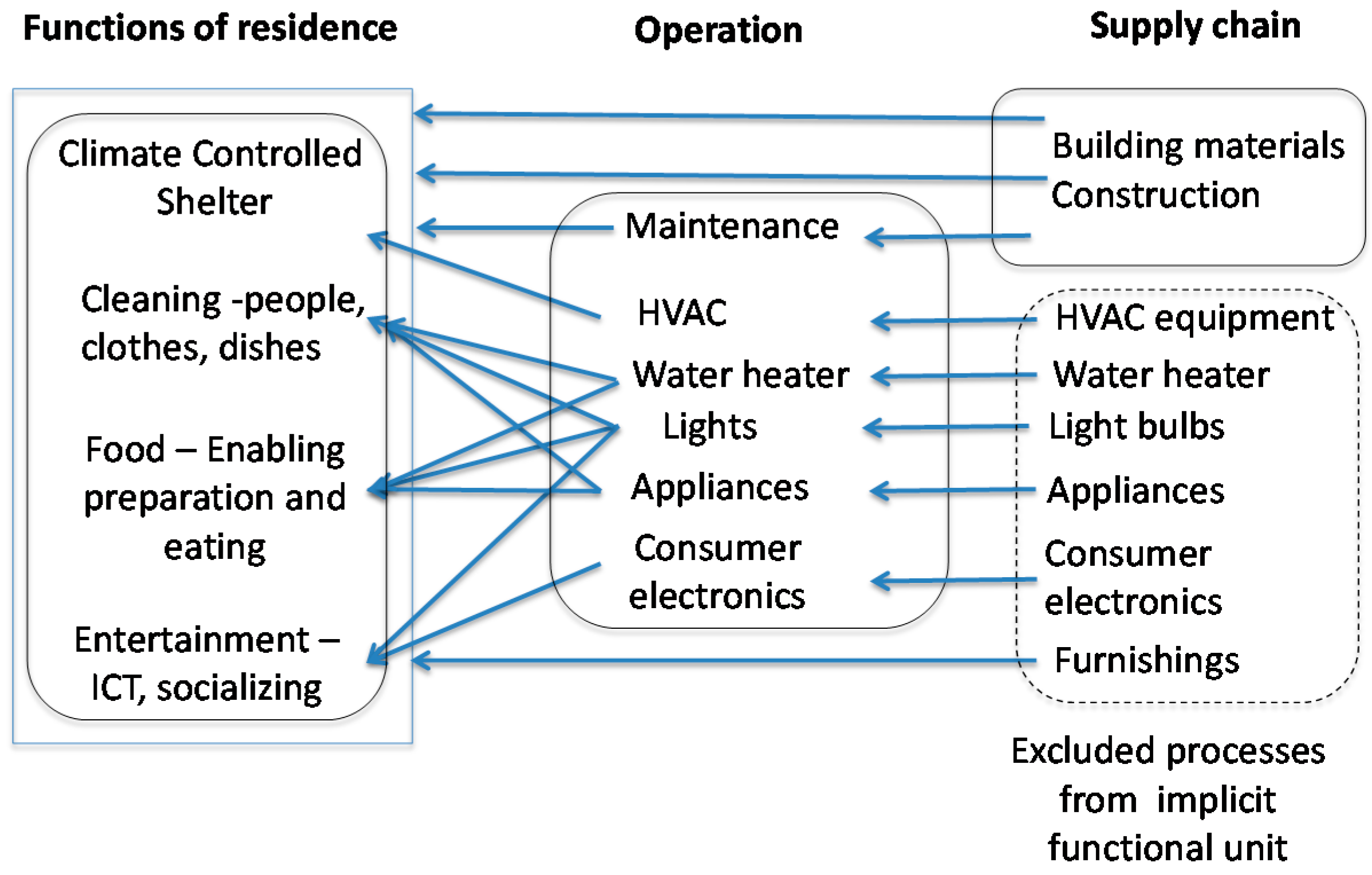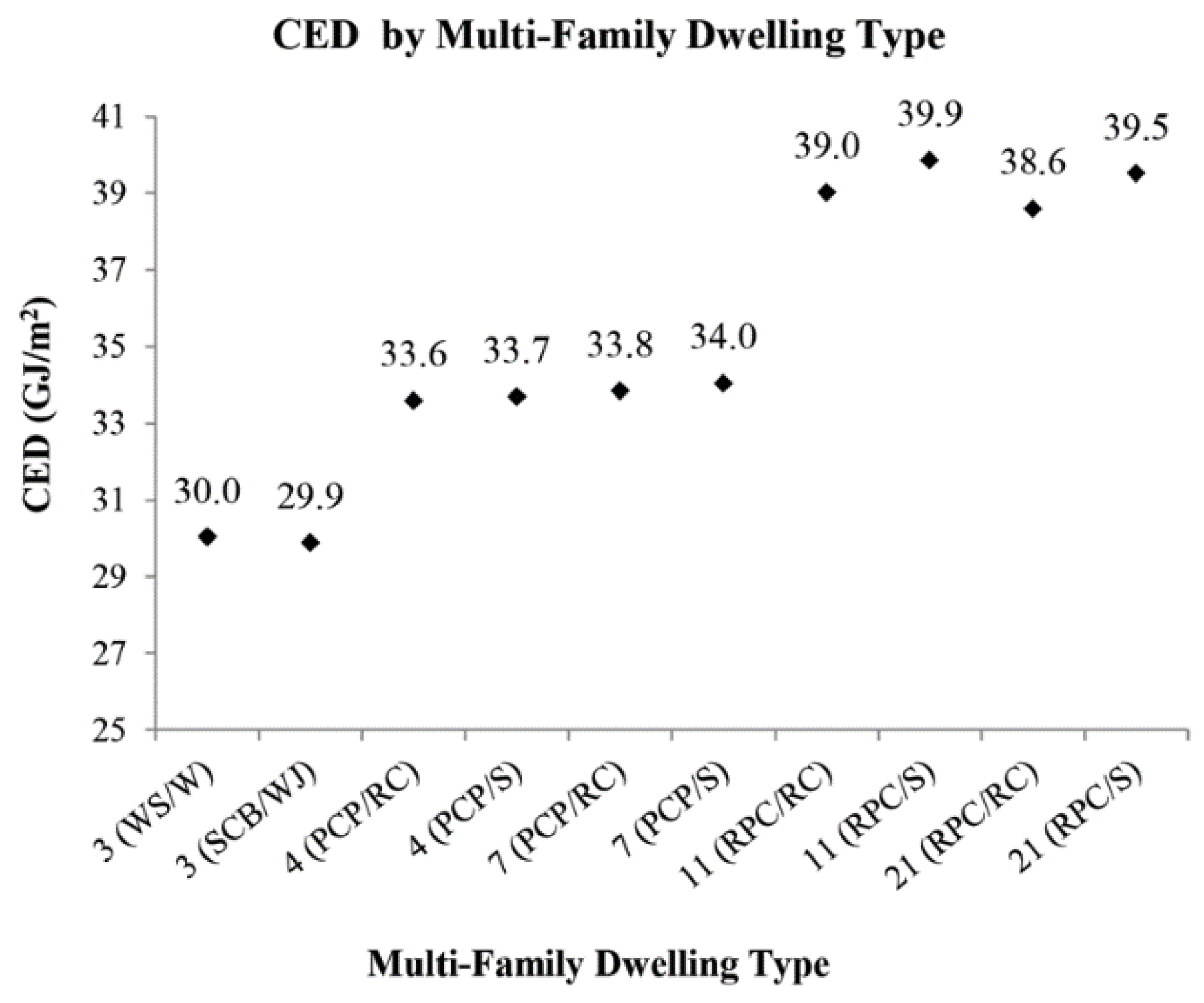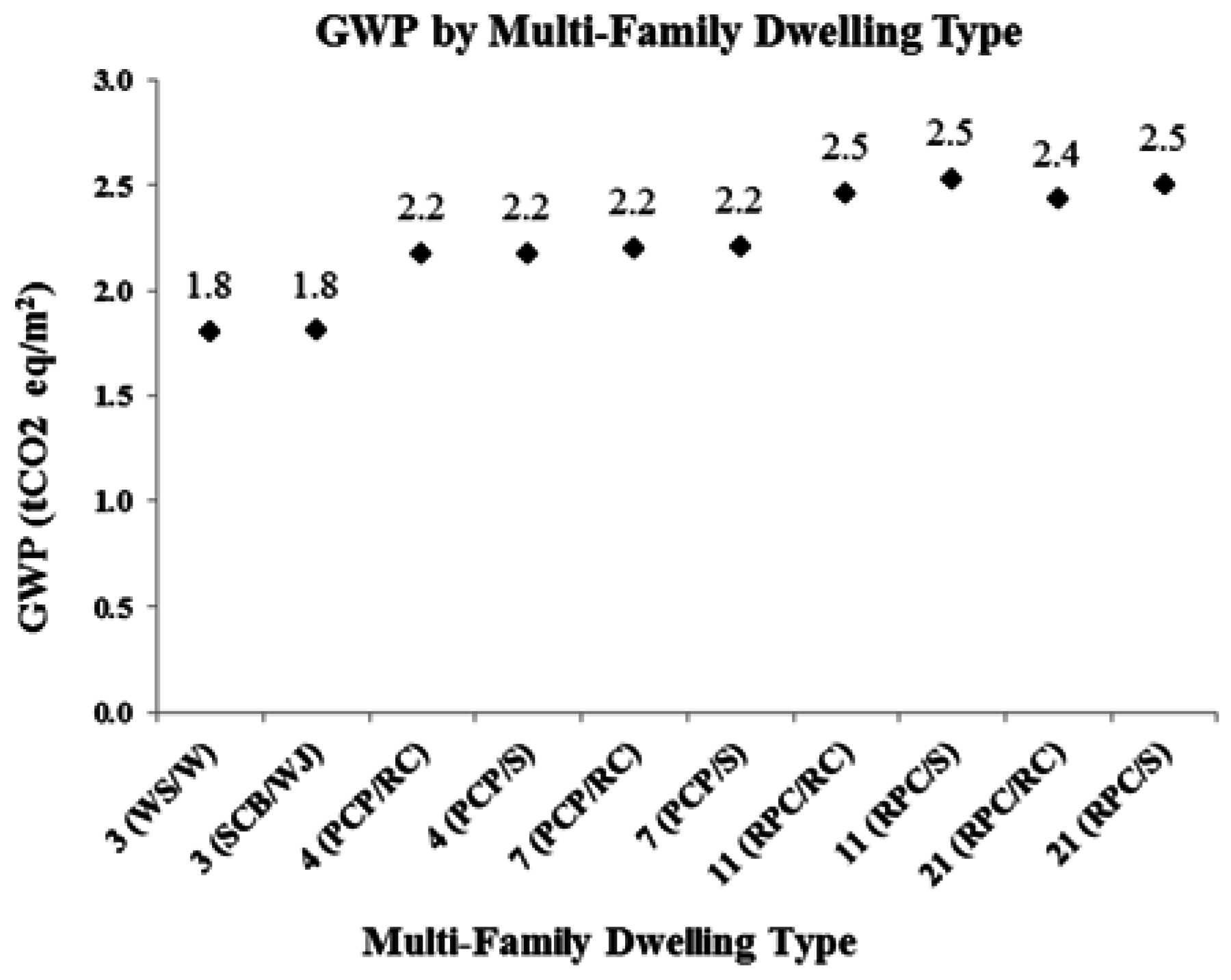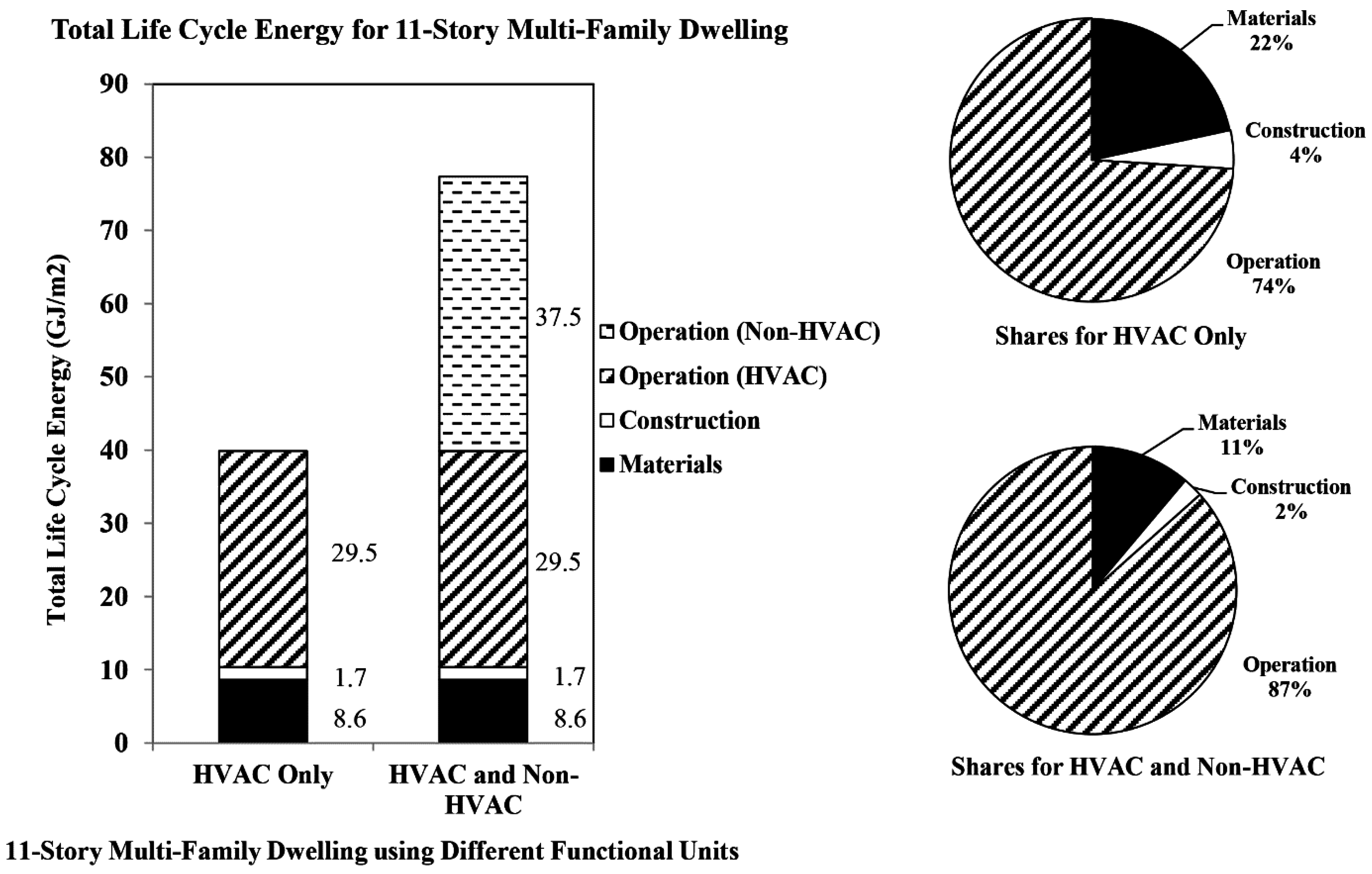Hybrid Life Cycle Assessment of Low, Mid and High-Rise Multi-Family Dwellings
Abstract
:1. Introduction
2. Methods
2.1. Functional Unit Choice and System Boundary


2.2. Life Cycle Inventory
2.3. Exploring Effects of Income on Life Cycle Energy of Multi- and Single-Family Homes
3. Analysis
3.1. Object of Analysis
| Number of Stories | Rise | Square Feet | Square Meters | Exterior Wall | Frame | Perimeter (meters) |
|---|---|---|---|---|---|---|
| 3 | Low | 30,500 | 2837 | Wood siding | Wood Frame | 56 |
| 3 | Low | 30,500 | 2837 | Stucco on Concrete Block | Wood Joists | 56 |
| 4 | Mid | 65,000 | 6045 | Precast Concrete Panels | Steel Frame | 74 |
| 4 | Mid | 65,000 | 6045 | Precast Concrete Panels | Reinforced Concrete Frame | 74 |
| 7 | Mid | 60,000 | 5580 | Precast Concrete Panels | Steel Frame | 47 |
| 7 | Mid | 60,000 | 5580 | Precast Concrete Panels | Reinforced Concrete Frame | 47 |
| 11 | High | 80,750 | 7510 | Ribbed Precast Concrete | Steel Frame | 37 |
| 11 | High | 80,750 | 7510 | Ribbed Precast Concrete | Reinforced Concrete Frame | 37 |
| 21 | High | 216,500 | 20,135 | Ribbed Precast Concrete | Steel Frame | 51 |
| 21 | High | 216,500 | 20,135 | Ribbed Precast Concrete | Reinforced Concrete Frame | 51 |
3.2. Materials Contribution: Economic Input-Output Life Cycle Assessment (LCA)
| Line # | Line Item Description a | Extended Material Price a ($) | EIO Sector d | PPR b × PPI c | CED Intensity d (MJ/$) | CED (MJ) |
|---|---|---|---|---|---|---|
| 8 | Structural concrete, ready mix, normal weight, 3000 psi, includes local aggregate, sand, Portland cement and water, delivered, excludes all additives and treatments | 510 | 237320 Ready mix concrete manufacturing | 0.49 | 23.5 | 5882 |
3.3. Construction: Economic Allocation Approach
3.4. Operation: Process Approach
4. Results
4.1. Multi-Family Life Cycle Impact Assessment



4.2. Comparing Multi-Family and Single-Family Detached Residences for Different Incomes

5. Discussion
5.1. Main Results
5.2. Uncertainty
Acknowledgments
Author Contributions
Conflict of Interest
References
- United Nations, General Assembly. City Planning will Determine Pace of Global Warming. Available online: http://www.un.org/press/en/2007/gaef3190.doc.htm (accessed on 4 September 2013).
- United Nations Environment Programme (UNEP). Sustainable Buildings and Climate Initiative, Why Buildings. Available online: http://www.unep.org/sbci/AboutSBCI/Background.asp (accessed on 16 February 2013).
- U.S. Environmental Protection Agency. Life Cycle Assessment: Principles and Practice; Scientific Applications International Corporation (SAIC): Reston, VA, USA, 2006.
- Adalberth, K. Energy use during the life cycle of single-unit dwellings: Examples. Build. Environ. 1997, 32, 321–329. [Google Scholar] [CrossRef]
- Cole, R.J.; Kernan, P.C. Life-cycle energy use in office buildings. Build. Environ. 1996, 31, 307–317. [Google Scholar] [CrossRef]
- Keoleian, G.A.; Blanchard, S.; Reppe, P. Life-cycle energy, costs, and strategies for improving a single-family house. J. Ind. Ecol. 2001, 4, 135–156. [Google Scholar] [CrossRef]
- Junnila, S.; Horvath, A.; Guggemos, A.A. Life-cycle assessment of office buildings in Europe and the United States. J. Infrastruct. Syst. 2006, 12, 10–17. [Google Scholar] [CrossRef]
- Ramesh, T.; Prakash, R.; Shukla, K.K. Life cycle energy analysis of buildings: An overview. Energy Build. 2010, 42, 1592–1600. [Google Scholar] [CrossRef]
- Sharma, A.; Saxena, A.; Sethi, M.; Shree, V.; Varun. Life cycle assessment of buildings: A review. Renew. Sustain. Energy Rev. 2011, 15, 871–875. [Google Scholar]
- Thormark, C. A low energy building in a life cycle—Its embodied energy, energy need for operation and recycling potential. Build. Environ. 2002, 37, 429–435. [Google Scholar] [CrossRef]
- Stephan, A.; Crawford, R.H.; de Myttenaere, K. A comprehensive assessment of the life cycle energy demand of passive houses. Appl. Energy 2013, 112, 23–34. [Google Scholar] [CrossRef]
- Crawford, R.H.; Stephan, A. The significance of embodied energy in certified passive houses. World Acad. Sci. Eng. Technol. 2013, 78. [Google Scholar] [CrossRef]
- Stephan, A.; Stephan, L. Reducing the total life cycle energy demand of recent residential buildings in Lebanon. Energy 2014, 74, 618–637. [Google Scholar] [CrossRef]
- Sartori, I.; Hestnes, A.G. Energy use in the life cycle of conventional and low-energy buildings: A review article. Energy Build. 2007, 39, 249–257. [Google Scholar] [CrossRef]
- Cabeza, L.F.; Rincón, L.; Vilariño, V.; Pérez, G.; Castell, A. Life cycle assessment (LCA) and life cycle energy analysis (LCEA) of buildings and the building sector: A review. Renew. Sustain. Energy Rev. 2014, 29, 394–416. [Google Scholar] [CrossRef]
- Gong, X.; Nie, Z.; Wang, Z.; Cui, S.; Gao, F.; Zuo, T. Life cycle energy consumption and carbon dioxide emission of residential building designs in Beijing. J. Ind. Ecol. 2012, 16, 576–587. [Google Scholar] [CrossRef]
- Frijia, S.; Guhathakurta, S.; Williams, E.D. Functional unit, technological dynamics and scaling properties for the life cycle energy of residences. Environ. Sci. Technol. 2011, 46, 1782–1788. [Google Scholar] [CrossRef]
- Stephan, A.; Crawford, R.H.; de Myttenaere, K. Towards a comprehensive life cycle energy analysis framework for residential buildings. Energy Build. 2012, 55, 592–600. [Google Scholar] [CrossRef]
- Dixit, M.K.; Culp, C.H.; Fernández-Solís, J.L. System boundary for embodied energy in buildings: A conceptual model for definition. Renew. Sustain. Energy Rev. 2013, 21, 153–164. [Google Scholar] [CrossRef]
- Scheuer, C.; Keoleian, G.A.; Reppe, P. Life cycle energy and environmental performance of a new university building: modeling challenges and design implications. Energy Build. 2003, 35, 1049–1064. [Google Scholar] [CrossRef]
- Treloar, G.J.; Fay, R.; Ilozor, B.; Love, P.E.D. An analysis of the embodied energy of office buildings by height. Facilities 2001, 19, 204–214. [Google Scholar] [CrossRef]
- Norman, J.; MacLean, H.L.; Kennedy, C.A. Comparing high and low residential density: Life-cycle analysis of energy use and greenhouse gas emissions. J. Urban Plan. Dev. 2006, 132. [Google Scholar] [CrossRef]
- Holden, E.; Norland, I.T. Three challenges for the compact city as a sustainable urban form: household consumption of energy and transport in eight residential areas in the greater Oslo region. Urban Stud. 2005, 42, 2145–2166. [Google Scholar] [CrossRef]
- Ko, Y. Urban form and residential energy use a review of design principles and research findings. J. Plan. Lit. 2013, 28, 327–351. [Google Scholar] [CrossRef]
- Ewing, R.; Rong, F. The impact of urban form on US residential energy use. Hous. Policy Debate 2008, 19, 1–30. [Google Scholar] [CrossRef]
- Stephan, A.; Crawford, R. H.; de Myttenaere, K. Multi-scale life cycle energy analysis of a low-density suburban neighbourhood in Melbourne, Australia. Build. Environ. 2013, 68, 35–49. [Google Scholar] [CrossRef]
- Heinonen, J.; Junnila, S. Implications of urban structure on carbon consumption in metropolitan areas. Environ. Res. Lett. 2011, 6. [Google Scholar] [CrossRef]
- Treloar, G.J.; Fay, R.; Love, P.E.D.; Iyer-Raniga, U. Analysing the life-cycle energy of an Australian residential building and its householders. Build. Res. Inf. 2000, 28, 184–195. [Google Scholar] [CrossRef]
- Williams, E.D.; Weber, C.L.; Hawkins, T.R. (2009) Hybrid framework for managing uncertainty in life cycle inventories. J. Ind. Ecol. 2009, 13, 928–944. [Google Scholar] [CrossRef]
- Leontief, W. Environmental repercussions and the economic structure: an input-output approach. Rev. Econ. Stat. 1970, 52, 262–271. [Google Scholar] [CrossRef]
- Bullard, C.W.; Herendeen, R.A. The energy cost of goods and services. Energy Policy 1975, 3, 268–278. [Google Scholar] [CrossRef]
- Chris, H.; Horvath, A.; Joshi, S.; Lave, L. Peer reviewed: Economic input-output models for environmental life-cycle assessment. Environ. Sci. Technol. 1998, 32, 184A–191A. [Google Scholar] [CrossRef]
- Bullard, C.W.; Penner, P.S.; Pilati, D.A. Net energy analysis: Handbook for combining process and input-output analysis. Resour. Energy 1978, 1, 267–313. [Google Scholar] [CrossRef]
- Williams, E. Energy intensity of computer manufacturing: Hybrid assessment combining process and economic input-output methods. Environ. Sci. Technol. 2004, 38, 6166–6174. [Google Scholar] [CrossRef] [PubMed]
- Reed Construction Data Inc. RS MeansOn-line; Reed Construction Data Inc.: Norcross, GA, USA, 2012. [Google Scholar]
- Residential Energy Consumption Survey (RECS), RECS 2009 Survey Data, Microdata. Available online: http://www.eia.gov/consumption/residential/data/2009/index.cfm?view=microdata (accessed on 1 December 2013).
- Van Engelenburg, B.; van Rossum, T.; Blok, K.; Vringer, K. Calculating the energy requirments of household purchases: A practical step by step method. Energy Policy 1994, 22, 648–656. [Google Scholar] [CrossRef]
- Zhai, P.; Williams, E.D. Dynamic hybrid life cycle assessment of energy and carbon of multicrystalline silicon photovoltaic systems. Environ. Sci. Technol. 2010, 44, 7950–7955. [Google Scholar] [CrossRef] [PubMed]
- Carnegie Mellon University Green Design Institute. Economic Input-Output Life Cycle Assessment (EIO-LCA) US 2002 (428) Model [Internet]. Available online: http://www.eiolca.net/ (accessed on 10 July 2012).
- Source Energy and Emission Factors for Energy Use in Buildings. Available online: http://www.nrel.gov/docs/fy07osti/38617.pdf (accessed on 10 July 2012).
- Residential Energy Consumption Survey (RECS), Housing Characteristics. Available online: http://www.eia.gov/consumption/residential/data/2009/index.cfm?view=characteristics#undefined (accessed day 10 February 2014).
- Fuller, R.J.; Crawford, R.H. Impact of past and future residential housing development patterns on energy demand and related emissions. J. Hous. Built Environ. 2011, 26, 165–183. [Google Scholar] [CrossRef]
- Intergovernmental Panel on Climate Change (IPCC). Fourth Assessment Report. Available online: http://www.ipcc.ch/publications_and_data/ar4/wg1/en/ch2s2-10-2.html#table-2-14 (accessed on 4 June 2012).
- U.S. Census Bureau. North American Industry Classification System. Available online: http://www.census.gov/prod/ec02/ec0223i236116.pdf (accessed on 2 July 2013).
- U.S. Bureau of Economic Analysis. Benchmark Input-Output Data. Available online: http://www.bea.gov/industry/io_benchmark.htm (Accessed 21 June 2012).
- U.S. Bureau of Labor Statistics. Producer Price Indexes. Available online: http://www.bls.gov/ppi/ (accessed on 21 June 2012).
- U.S. Census Bureau. Economic Census, Industry Series Reports, Construction, New Multifamily Housing Construction (Except Operative Builders). Available online: http://www.census.gov/prod/ec02/ec0223i236116.pdf (accessed on 17 September 2012).
- Residential Energy Consumption Survey (RECS), RECS 2009 Survey Data. Consumption and Expenditures. Available online: http://www.eia.gov/consumption/residential/data/2009/index.cfm?view=consumption (accessed on 1 December 2013).
- RDH Building Engineering Ltd. Energy Consumption and Conservation in Mid- and High-Rise Residential Buildings in British Columbia; RDH Building Engineering Ltd.: Vancouver, BC, Canada, 2012. [Google Scholar]
- Residential Energy Consumption Survey (RECS). Available online: http://www.eia.gov/consumption/residential/data/2009/index.cfm (accessed on 10 February 2014).
- Residential Energy Consumption Survey RECS, Housing Characteristics, Table HC10.1 Total Square Footage of U.S. Homes, by Housing Characteristics. Available online: http://www.eia.gov/consumption/residential/data/2009/index.cfm?view=characteristics#undefined (accessed on 1 December 2013).
- Residential Energy Consumption Survey (RECS), 2009 Technical Documentation Summary. Available online: http://www.eia.gov/consumption/residential/methodology/2009/pdf/techdoc-summary010413.pdf (accessed on 9 January 2014).
© 2015 by the authors; licensee MDPI, Basel, Switzerland. This article is an open access article distributed under the terms and conditions of the Creative Commons Attribution license (http://creativecommons.org/licenses/by/4.0/).
Share and Cite
Bawden, K.; Williams, E. Hybrid Life Cycle Assessment of Low, Mid and High-Rise Multi-Family Dwellings. Challenges 2015, 6, 98-116. https://doi.org/10.3390/challe6010098
Bawden K, Williams E. Hybrid Life Cycle Assessment of Low, Mid and High-Rise Multi-Family Dwellings. Challenges. 2015; 6(1):98-116. https://doi.org/10.3390/challe6010098
Chicago/Turabian StyleBawden, Kimberly, and Eric Williams. 2015. "Hybrid Life Cycle Assessment of Low, Mid and High-Rise Multi-Family Dwellings" Challenges 6, no. 1: 98-116. https://doi.org/10.3390/challe6010098





